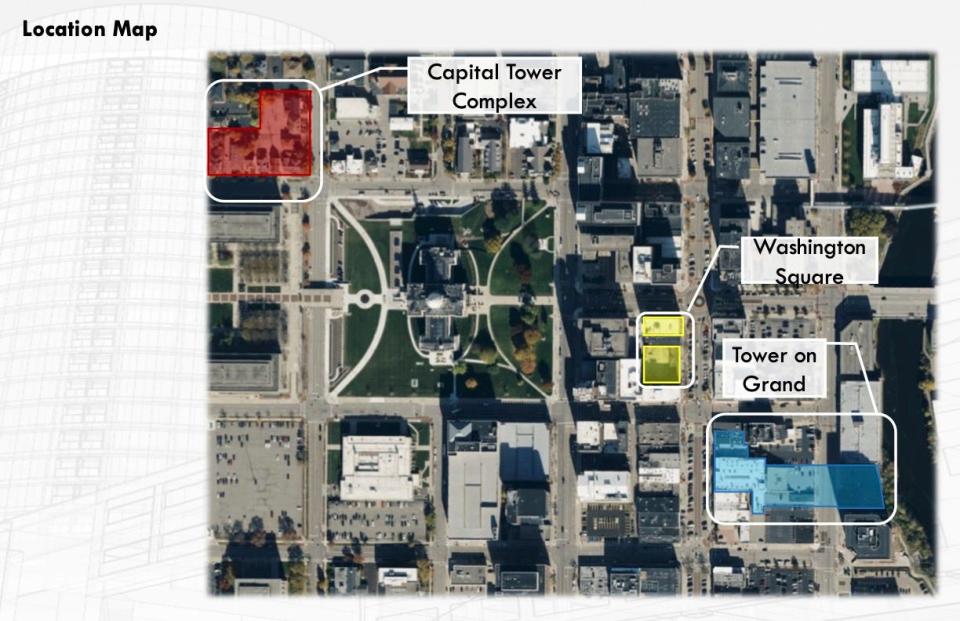Developers: Having some Michigan State students downtown could cement city's future
EAST LANSING — One way to boost downtown Lansing's economy and foot traffic is to get its Michigan State University neighbors to move hundreds of students there, according to some of the city's leading developers and commercial landlords.
Pat Gillespie, whose Gillespie Group has developed the Stadium District among other projects in and near the city, said bringing 500 MSU students, along with the university's "giant block S," downtown would change the city's prospects forever.
Gillespie spoke Thursday at a luncheon hosted by the Lansing Regional Chamber of Commerce, with experts talking about the future of downtown, which has been battered by an exodus of state workers during the pandemic. He was joined by Cathleen Edgerly, executive director of Downtown Lansing Inc.; John Hindo, president of the Boji Group; and Van Martin, the head of Martin Commercial Properties.
Martin pointed to Michigan State University's investments in Detroit and Grand Rapids. The university has for years invested in downtown Grand Rapids, building out a campus there for the College of Human Medicine. MSU through its endowment bought a controlling stake in Detroit's Fisher Building this summer as well as two adjacent surface parking lots and a parking structure for $21 million to help build an incubation center there as well as accommodate educational and community plans.
MSU spokeswoman Emily Guerrant did not respond to a request for comment for this story.
Interim President Teresa Woodruff in an opinion column published by the State Journal in June wrote that "As I outlined at a recent Lansing Regional Chamber Economic Club presentation, the scope of MSU’s engagement with community partners is vast — hundreds of local programs, from supporting local schools with leadership development and classroom volunteers, interns and trained teachers; to medical and nursing school faculty members staffing hospitals and clinics; to funding and other opportunities available through MSU’s growing entrepreneurial ecosystem." She added that MSU creates more than $3 billion in economic impact and spends over $140 million with local businesses in Ingham, Clinton, Eaton and Shiawassee counties.

The discussion Thursday focused almost entirely on downtown recovery and getting people into the central district. There has been an exodus since the pandemic because of people working from home. For example, state officials across the region aren't sure how many of the state's roughly 48,000 workers are doing their jobs in downtown Lansing these days, and the State Budget Office doesn't track those numbers. But officials across the region agree it’s substantially less than the estimated 30,000 state workers who were commuting to downtown prior to the pandemic.
Tim Damon, president and CEO of the chamber, said downtown is the urban core of Lansing.
He said MSU bringing students to downtown would be a big boost, whether for be a few courses or a whole college, and university efforts to keep boosting the Lansing-East Lansing corridor will be important.
"We need the university engaged at that level," he said.
The Lansing of the near future will not have the same office space demands as it did a decade ago, Martin said. His group had about 270,000 square feet of empty office space before the pandemic. That's now 700,000 square feet in vacant office space, he said.
"The state of Michigan is our benefactor," Martin said. "We need not only their money but their presence."
Office space is already evolving, toward a more welcoming environment for employees, said Hindo, whose company controls Lansing's tallest building, the Boji Tower.
He said some of the company's properties, in Birmingham and Royal Oak, have a 6% vacancy rate. Martin said the Lansing area's vacancy rate was about 13.7% in 2019 and is 25.9% now.
Hindo said his company's Birmingham and Royal Oak buildings charge some of the state's highest rents. It's because those tenants want enjoyable, walkable spaces for employees to encourage them to come to the office, Hindo said.
"People want a lifestyle and to feel like a community," he said.
Tenants, at those buildings, say they are more interested in a vibrant lifestyle that encourages employees to work than they are in lower rents, Hindo said.
Hindo and the other developers highlighted other current projects that could help make downtown vibrant. Those developments include the following:
New Vision Lansing, announced in August. Plans are for three developments including a new tallest structure for Lansing. The $200 million project would bring about 450 residential units. It is being led by Paul, John and Tony Gentilozzi, along with Bloomfield Hills-based JFK Investment Company. JFK is owned by the Kosik family of Bloomfield Hills and led by Joseph Kosik.

Riverfront 220 is a $22.5 million, 63-unit development that would include two- and three-bedroom options. It is expected to break ground in 2024 and open in 2026.
MSUFCU Ovation is a performing arts venue that can accommodate large scale music concerts and a variety of other entertainment events. Construction began this summer.
Grewal Hall at 224 is a smaller downtown venue, nearing completion, with a capacity of around 900 for music events and able to accept banquets and other events.
Lansing has already seen hundreds of news apartments either built or under construction in recent years.
Contact Mike Ellis at mellis@lsj.com or 517-267-0415
This article originally appeared on Lansing State Journal: Developers: Having some Michigan State students downtown could cement city's future

